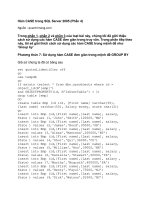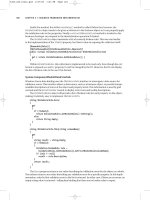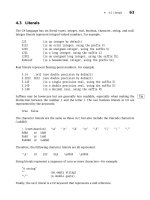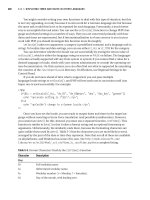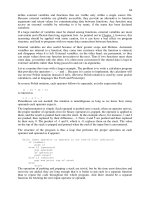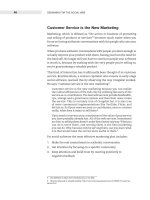EBAY PHOTOGRAPHY THE SMART WAY 2005 phần 4 doc
Bạn đang xem bản rút gọn của tài liệu. Xem và tải ngay bản đầy đủ của tài liệu tại đây (102.95 KB, 23 trang )
44 EBAY PHOTOGRAPHY THE SMART WAY
Typical Shutter Speeds (seconds)
1
1
/
2
1
/
4
1
/
8
1
/
15
1
/
30
1
/
60
1
/
125
1
/
250
1
/
500
1
/
1000
Notice that each speed is twice as fast as the next slower speed and half
as fast as the next higher speed. For instance,
1
/
500
of a second is twice
as fast as
1
/
250
of a second but half as fast as
1
/
1000
of a second. Each
increment is called a stop.
Aperture
The diaphragm on the lens is the mechanism which enables the hole
through which the light passes to change size. The hole is called the
aperture. When the diaphragm is completely opened, the aperture is
large, and it lets a huge amount of light thorough. When the dia-
phragm is closed to the size of a pinhole, the aperture is tiny, and it lets
only a little bit of light through. With this in mind, you want to close
the aperture on a bright and sunny day so as to not let too much light
come through to the film or photo sensor. On a dark or dreary day you
CHAPTER 4 TRADITIONAL PHOTOGRAPHY 45
want to open the aperture so as to let as much light through as possible
in order to get a good photograph.
Aperture settings, called f-stops, are determined by the manufacturer
according to the focal length of the lens. Here are some typical f-stops
for a digital camera:
Typical f-Stops
f2.8
f3.5
f5.6
f8
f11
Note that each f-stop lets in half as much light as the next lower f-stop
and twice as much light as the next higher f-stop. For example, f3.5
lets in twice as much light as f5.6 but only half as much light as f2.8.
Each increment is called a stop.
Coordination
When you take a photograph, you have to coordinate these three vari-
ables in order to take a properly exposed photograph. For a film cam-
era, when you put in a roll of film, you set the ISO. You can’t reset ISO
until you take the roll of film out and put in another roll with a differ-
ent ISO.
When you set the shutter speed, you do it according to a chart supplied
by the film maker for a specific film (with a specific ISO). Likewise
when you set the aperture, you set it according to a chart supplied by
the film maker. Different types of films (with different ISOs) have dif-
ferent charts. The goal is to coordinate the shutter speed with the aper-
ture so that they let in exactly the right amount of light to take a
properly exposed photograph for the ISO film you have in the camera.
46 EBAY PHOTOGRAPHY THE SMART WAY
If you want a high-speed picture (i.e., one taken with a very fast shut-
ter speed) in order to stop athletic or other action outdoors, you nor-
mally will coordinate that with a larger aperture (e.g., f2.8). Even
though the shutter doesn’t let in much light, the large aperture allows
enough light to get to the film.
On the other hand, if you don't care about stopping action, such as
when taking a landscape photograph, you might seek to get the great-
est depth of field for your photograph. The greater the depth of field in
your photograph, the more things in both the foreground and the
background will be in focus. To get the greatest depth of field, the
aperture needs to be the smallest (e.g., f11), not letting very much
light through. In order to get a well-exposed photograph, you’ll have
to compensate by setting the shutter slower.
So you can see, for a film camera you essentially have two controls that
you need to coordinate. The shutter speed and the aperture are set-
tings you must make for every photograph. You set the ISO when you
load a film with a specific ISO.
For a digital camera, you have three variables that you must adjust.
Remember, the photo sensor’s ISO (sensitivity) can be adjusted elec-
tronically by the camera. Hence, you can actually set a different ISO
for each photograph. As a result, to get good photographs from a digi-
tal camera requires that you make three settings for each photograph
that you take.
Automation
If you’re a professional photographer, you will want the most control
you can get over the camera, and you’re likely to use manual controls.
However, if you’re an amateur photographer or even an amateur pho-
tographer with professional skills, you may be perfectly happy if you
let the camera make all the adjustments for you. Indeed most cam-
eras—even professional ones—will automatically set the shutter speed
and the aperture for you for each photograph that you take. A digital
CHAPTER 4 TRADITIONAL PHOTOGRAPHY 47
camera will even adjust the ISO automatically for you for each photo-
graph. With modern electronic technology, such automation works
amazingly well for all photographers. However, there are always those
times when the lighting is so crazy that you have to take manual con-
trol of the camera in order to get a good photograph.
How does the camera control the shutter speed and the aperture? It
uses a light meter to determine what the lighting conditions are in the
photograph that you are about to take. It uses that information to set
the camera adjustments so that the camera takes a perfect picture.
In the old days, the camera’s light meter indicated to you, the photog-
rapher, what manual settings to make. Cameras then evolved to the
point where the camera now makes those settings for you so you don't
have to do it yourself. However, for those shots where you need to con-
trol the camera yourself, the camera offers you several choices.
Aperture Priority
You can set the camera so that you control the aperture; this is called
aperture priority. When you manually set the aperture properly, the
camera will automatically take care of the other adjustments. Again,
one situation in which you would want to use aperture priority would
be to shoot a landscape photograph where you are concerned with
having the greatest depth of field possible in order to bring everything
in the foreground and the background sharply in focus. By setting the
aperture small (e.g., f11), you create a photograph with this effect.
On the other hand you might want to take a picture where there’s a
very narrow depth of field. A portrait is a good example. In a portrait,
you want to have only the person’s face in focus. The person’s face is
the foreground. You want to have the background out of focus. If the
background is in focus too, it detracts from the portrait. Therefore, for
portraits you want to set the aperture large (e.g., f2.8). Aperture prior-
ity enables you to control the size of the aperture.
48 EBAY PHOTOGRAPHY THE SMART WAY
Shutter Priority
When you set the camera on shutter priority, you must set the shutter
speed. According to the shutter speed you set, the camera automati-
cally adjusts the other controls to take a well-exposed photograph.
Again, you might use shutter priority to take action pictures. For
instance, suppose you want to freeze the action in a local football
game. Set the camera on a fast shutter speed (e.g.,
1
/
1000
), stop the
action, and get a very sharp photograph. The camera takes care of the
other adjustments, and the camera will make the aperture larger to
compensate for your fast shutter speed. For a digital camera, the cam-
era may even adjust the ISO setting.
ISO
Automatic is the default setting in a digital camera for the ISO. That
means the digital camera will set the ISO automatically for each pho-
tograph you take. The question becomes, Why do I want to set the
ISO? The answer to that varies with different digital cameras. For
inexpensive digital cameras with small sensors, you get the best photo-
graphs at low ISOs. Most cameras with small photo sensors will start
to show degraded (noisy) photographs at ISOs over 100 or 200. Virtu-
ally all will show noise at ISOs of 400 and above. On the other hand,
expensive SLR cameras with large sensors can take high-quality pho-
tographs at ISOs of 400, 800, and even 1600.
Noise
Noise is individual pixels showing incorrect colors. It shows most
distinctly in broad expanses of identical (or similar) color in photo-
graphs. For instance, a large dark grey shadow in a digital photo-
graph may slow tiny flecks of a slightly lighter color.
Thus, if you have an expensive camera with a large photo sensor, you
probably won't worry too much about ISO settings. But if you’re using
CHAPTER 4 TRADITIONAL PHOTOGRAPHY 49
an inexpensive camera with a small sensor, you might want to set the
ISO at 50 or 100 permanently in order to take the highest quality pho-
tographs you can get. In that case, the camera doesn’t have any choice.
When you set the ISO manually, the camera will not adjust it.
Manual Adjustments
You need to learn to do manual adjustments, even if you don't use
them. Learning helps you understand what’s going on in the process
of taking a photograph. You normally change the ISO, the shutter
speed, or the aperture by standard increments (stops). One stop is
twice as much as the prior increment and half as much as the next
increment. So if you increase the ISO from 50 to 100, you increase it
one stop. Notice that the ISO doubled from 50 to 100. To increase the
ISO another stop, you have to change it to 200. If you change it
another stop beyond that, you have to change it to 400. So going up
each stop is twice as much as the setting before, and going down each
stop is half as much as the setting before.
For the shutter speed, you might start with
1
/
4
of a second. In order to
go up a stop, you have to go to
1
/
8
of a second. Next is
1
/
16
and so forth.
The aperture is a more complex measurement, and the manufacturer
of the lens normally determines the stops and labels them for each
particular lens. Therefore, you simply read the settings for the lens.
They are one stop apart.
How Do All of These Work Together?
The chart below shows the stops for a lens together with shutter
speeds and apertures. At the top of the chart are the settings to keep
the most light out, and at the bottom of the chart are the settings to let
the most light in—all in one-stop increments:
50 EBAY PHOTOGRAPHY THE SMART WAY
ISO Shutter Speed Aperture
50
1
/
1000
f 11
100
1
/
500
f 8
200
1
/
250
f 5.6
400
1
/
125
f 3.5
800
1
/
60
f 2.8
1600
1
/
30
1
/
15
1
/
8
1
/
4
1
/
2
With film cameras, you only have two adjustments to make: the shut-
ter speed and the aperture. That makes manually adjusting the cam-
era relatively simple. With the advent of digital cameras, however, you
can now adjust the ISO setting too. With three variables, making the
adjustments manually can be mind-boggling.
That’s why many professionals allow the camera to make at least one
or two of the adjustments automatically for each photograph. You
need to understand how this works. Why? Because you may have a
reason for making a specific setting.
For instance, if you want to get the highest quality photograph with an
inexpensive digital camera (with a small sensor), you may want to set
the ISO at 100. Likewise, if you want to stop some fast moving action,
like the players in a football game, you may want to set the shutter to a
high speed, say
1
/
1000
of a second. Similarly, if you’re taking a photo-
graph for which you specifically need a greater depth of field (e.g.,
CHAPTER 4 TRADITIONAL PHOTOGRAPHY 51
landscape), you will need to set the aperture to a high f-stop.
Whenever you have the desire to set one or two of these three, the
other one or two must be adjusted also. In most cases, it’s probably
best to let the camera make the adjustments automatically. Nonethe-
less, as we mentioned before, there are certain situations where you
may want to set all three yourself. And to make such settings work
well, you have to understand how these three adjustments work
together.
Examples
Set your point-and-shoot digital camera at ISO 100 for all your work.
This is a good strategy. At 100 you have twice as much sensitivity as at
50, but you’re unlikely to get noise. Now, suppose you set the camera
to automatic, and it shows that it’s going to take the next photograph
at f3.5 at
1
/
125
of a second. You would like to have greater depth of field
for your product photography just to make sure each entire product is
in focus. You decide to set the f-stop at f8. What is the appropriate
shutter setting? Well, you’ve shut down the f-stop to f8, so you now
need to slow down the shutter speed two stops to compensate. You
must set the new shutter speed at
1
/
30
of a second.
Normally, for hand-held photography,
1
/
30
of a second would be too
slow. Hand-held photography should seldom be slower than
1
/
125
of a
second, and
1
/
250
is better. But you normally shoot products in a studio
with a tripod, so
1
/
30
is OK.
Conclusion
A good way to get a feel for these adjustments is to look at the charts
published by film manufacturers for a specific film (i.e., a specific
ISO) that show the relationship between shutter speed and aperture
for various lighting conditions. For instance, you can find charts for
Kodak film at the Kodak website (). In those
52 EBAY PHOTOGRAPHY THE SMART WAY
charts you will see how these adjustments change for different lighting
conditions such as sunny and clear; hazy; dark overcast; twilight; low
light; and so forth. If you can understand these three adjustments, you
have made a giant step forward in understanding how to take excel-
lent photographs.
53
5
Digital Photography
Digital cameras work pretty much the same way as film cameras. All
the same principles apply. There are a few extra things, however, to
keep in mind when using a digital camera. We have already covered
setting the ISO in Chapter 4, but there’s more. Most of these extras are
not something to worry about, but you should understand them none-
theless so as to be aware of the additional factors in taking high-qual-
ity digital photographs.
54 EBAY PHOTOGRAPHY THE SMART WAY
Camera Features
Digital cameras have a lot of features that traditional cameras do not.
The list here is a short list relevant to eBay product photography and is
not meant to be a comprehensive list for more general use.
Image Size
A digital camera can take images of differing size quality. Therefore,
you must set the size and quality you want to take. This is an easy
determination to make. You need to set your camera to take pictures at
the largest size possible and the highest quality possible while keeping
in mind the number of photographs you can store conveniently on a
memory card. The chart below indicates the choices you might have
for a typical 3-MP digital camera.
Resolution (pixels) Quality Images (16 MB Card)
2048 × 1536 Super-Fine 8
Fine 16
Normal 32
1600 × 1200 Super-Fine 14
Fine 26
Normal 52
1024 × 768 Super-Fine 25
Fine 46
Normal 84
640 × 480 Super-Fine 58
Fine 94
Normal 165
CHAPTER 5 DIGITAL PHOTOGRAPHY 55
The larger resolution dimensions (pixels) are higher quality because
they pack more pixels into the same photograph than do lower resolu-
tions.
The quality designation (different words for different manufacturers)
indicate the amount of JPEG compression applied to the photographs
as they are saved to the camera’s memory chip. JPEG compression is
lossy; that is, it loses quality. The loss of quality depends on the
amount of compression. For the camera above, Super-Fine is the high-
est quality with the least JPEG compression. Normal is the lowest
quality with the most compression.
For the camera above, 2048 × 1536 pixels at Super-Fine gives you the
highest quality picture possible with which to work and create a good
eBay item photograph. Naturally, the more megapixels you have, the
higher resolution your photographs can be. The chart below indicates
the largest image you can get from cameras with various megapixel
ratings.
Resolution (pixels) MP
2048 × 1536 3
2272 × 1704 4
2560 × 1920 5
2848 × 2136 6
3072 × 2304 7
3264 × 2448 8
As we’ve said before, we don’t believe you need more than a 3-MP
camera to do high-quality eBay photography. Since you get an image
that’s about 2000 × 1500 pixels with a 3-MP camera, that appears to
be substantial overkill to create a photograph that’s 400 × 300 pixels
for your eBay auction ad. Indeed, it’s about 25 times as big as you
56 EBAY PHOTOGRAPHY THE SMART WAY
need. (This assumes that you fill the frame with the item being photo-
graphed, a technique we recommend you use.)
With this information in mind, our recommendation to you is that
you set your digital camera at its highest resolution and image quality,
use a memory card with plenty of memory, and then forget about it.
File Format
Another choice you need to make is the file format in which the cam-
era will store your photographs. We recommend JPEG. Although TIF
files and RAW files (used in more expensive cameras) are higher qual-
ity with less compression, JPEG files are more than enough to accom-
modate your purposes in taking eBay product photographs. If you use
TIF files or RAW files, they will require extra time in your post-pro-
cessing for very little additional quality, if any, for online display.
Therefore, we believe you’re wasting your time to use these more
robust file formats. Stick with JPEG.
White Balance
Different light sources have different color temperatures. The kind of
light you get on a bright, clear day is a very high color temperature.
The kind of light you get in a room with an incandescent light is a
lower color temperature. If you avoid mixing different kinds of light
together in one photograph, it may make your photography easier.
Since we cover white balance in Chapter 6, we won’t dwell on it here.
Nonetheless, we should mention that white balance is handled in film
cameras by using different types of film. There is indoor film that is
white balanced for tungsten light, and there is outdoor film that is
white balanced for sunny days. For digital cameras, the white balance
is a setting. Like many other electronic settings, the camera can do it
automatically, or you can do it manually. As for all camera settings,
you might find yourself in situations where you need to set the white
balance yourself rather than let the camera do it automatically.
CHAPTER 5 DIGITAL PHOTOGRAPHY 57
Viewfinder
Unless you have a digital SLR camera which shows the exact photo-
graph to be taken through the viewfinder, you are not always going to
see the picture you take through your viewfinder. Optical viewfinders
(not through the lens) have a parallax distortion, particularly close up.
The closer you get to the subject of the photograph, the greater the
parallax error. The greater the parallax error, the less likely it is that
you will be able to tell exactly what’s going to be in the photograph
and what’s not.
Fortunately, where digital cameras are superior to film cameras in this
regard is that digital cameras have an LCD screen on the back, which
shows exactly the photograph that you are going to take. In addition,
some digital cameras do not have an optical viewfinder but rather a
digital viewfinder. A digital viewfinder is like the LCD screen and pro-
vides an accurate view of the photograph to be taken. The problem
with digital viewfinders is that many of them are low resolution. Low
resolution digital viewfinders sometimes make it difficult to take pho-
tographs.
Under the circumstances, it would seem that a digital SLR would be
ideal for shooting eBay photographs. But a digital SLR, a relatively
expensive camera, is not necessary. As mentioned above, when shoot-
ing close-up photographs of items, you are more likely to rely on the
LCD screen on the back of the camera than you are on the viewfinder
itself. When shooting large objects outside such as cars, almost any
viewfinder will work well.
Macro Photography
A great advantage of most digital cameras is that they take good macro
photographs without any additional equipment. Macro photography
is simply taking photographs of small things and very small things
(e.g., jewelry). Because they have smaller lenses, most inexpensive
58 EBAY PHOTOGRAPHY THE SMART WAY
digital cameras have good macro capability. You have to turn on the
camera’s macro mode.
The alternative for more expensive digital cameras with larger lenses
and for digital SLR cameras is not so desirable. First, you may have to
add a close-up lens on the front of your lens. This is inconvenient.
When you’re doing normal photography, you’ll have to remove the
close-up lens. Your best bet if you’re going to use a digital SLR to do
macro photography is to buy a macro lens for it. Such lenses tend to be
expensive and are an additional expense for your eBay photography.
Of course if you are not going to do any macrophotography, this dis-
cussion is not relevant. But if you are doing general photography,
where you shoot large things one day and small things another, you’ll
need to have macro capability.
Image Review
One of the great advantages of a digital camera is that you can use the
LCD screen on the back of the camera to not only see the photograph
you are about to take but also to review the photographs that you’ve
taken. You don’t have to wait for the film to be developed and the
prints to be made before you can make sure that you’ve taken a photo-
graph adequate for your purposes. This is not a perfect review proce-
dure that works 100 percent of the time—primarily because the LCD
image is small—but nonetheless it works pretty well. This capability is
one of the better features of digital cameras, particularly for eBay prod-
uct photography.
Preview
The capability to preview the shot you will take is a convenient fea-
ture. You should be able to see exactly what you’re going to get on
the LCD screen. This is one reason why photo lights are better than
flashes for simple product photography. For a flash photograph,
CHAPTER 5 DIGITAL PHOTOGRAPHY 59
you have to wait until after you take the shot to evaluate the quality
of the resulting photograph.
ISO Setting
There’s no need here to rehash our discussion of ISO discussed in
Chapter 4 except to remind you that another advantage of digital cam-
eras is that you can set the ISO. This can be particularly important
when you take photographs in the same environment all the time,
such as in a studio where the lighting is pretty much the same for most
of your product photographs.
Other Capabilities
Because a digital image can be managed right inside the camera by the
camera itself, digital cameras have a huge advantage over film cam-
eras. However, most of the things that digital cameras can do are
beyond the scope of this book. Consequently, there are a lot of digital
camera capabilities that we do not cover here because such capabilities
are designed for general photography, and they’re not a convenience or
a significant benefit for people taking eBay product photographs.
Digital Zoom
One of the clever things a digital camera can do is zoom in to a greater
extent than can its optical zoom lens. Digitally, you can achieve a tele-
scopic effect twice or three times more than the lens of the camera can.
Unfortunately, even though you can do it, it doesn’t work very well.
When you start zooming digitally, the overall image degrades rapidly,
and pretty soon you may end up with a photograph that lacks quality
and sharpness. Therefore, we recommend that you never use the digi-
tal zoom capability of your digital camera. Just because the capability
exists does not mean that it is appropriate to use it.
60 EBAY PHOTOGRAPHY THE SMART WAY
Shutter Lag
You will notice that on most inexpensive digital cameras there is a lag
between the time you push the shutter down and when the camera
actually snaps the picture. That lag can be a second, a half second, a
quarter of a second. For eBay photography, it’s something you proba-
bly will not need to worry about because your subject (i.e., the eBay
item) presumably is always steady. That is, it doesn’t move. So a shut-
ter lag shouldn’t make any difference for most eBay photography.
Where a shutter lag might interfere with your photography is when
taking action photographs.
Similar to shutter lag but not identical is the fact that most digital
cameras require a start-up time. It might be several seconds or longer
from the time you turn on the camera until you can start to use it to
take photographs. Again, for product photography this is not a big
deal. For action photography where you might need to turn on your
camera and take photographs immediately on the spur of the moment,
a quick start-up time would be important to you.
Summary
Again, let us simply state that a digital camera is not much different
from a film camera in the way that it handles light. You are going to
have to be concerned with f-stops and shutter speeds. You can proba-
bly set the ISO and the white balance and forget them, particularly for
studio photography where the light environment is a constant. This
chapter outlines some of the features that make a digital camera differ-
ent from a film camera, and most of them are desirable features. What
these features mean to you is that you can take better photographs
with a digital camera for displaying your eBay items online than you
ever could with a film camera.
III
Product Photography Indoors
This page intentionally left blank
63
6
Indoor Photography Basics
The key to indoor photography is—guess what?—light. If you can
control the light, you can easily take great product photographs for
your eBay auction ads. If you can’t, your photographs may be substan-
dard and even exhibit strange effects, such as weird and unattractive
color tints. Fortunately, indoor light is not like outdoor light. Outdoors
you have to take what you get, and that may change from hour to hour
or even from minute to minute. Indoors, you can have total control
over light. It’s just a matter of knowing what to do with basic lighting
equipment to make light work for you.
64 EBAY PHOTOGRAPHY THE SMART WAY
Light
In order to control light, we need a means of evaluating it as well as a
means of measuring it. The built-in light meter in your camera mea-
sures the light intensity in order to set a proper exposure for taking a
photograph. We use light temperature measured in degrees Kelvin to
evaluate light. Whatever the light source, you want your camera to
show the light source as being white. But not all light is the same
color. Here are some examples:
Blue sky 11000K
Hazy sky 8000K
Daylight at noon 5500K
Typical daylight 5000K
Studio flood lights 3000K
Household light bulbs 2500K
Note that color temperature is not the same as brightness. Rather, it’s
the relative intensity of blue to red. Thus, household lights give you a
yellowish light while a sunless blue sky gives you a bluish light.
The process of setting a digital camera to show light from the light
source as being white light is called setting the white balance. (In a
film camera, the same is accomplished by using different types of
film.) Digital cameras are pretty good at setting the white balance
automatically, so why bother to comment on white balance?
Indoor light comes from different sources (e.g., daylight from a win-
dow and incandescent light from a light bulb), and that can result in
some atypical effects in your photographs. Consequently, the easiest
way to control light and white balance may be to use a uniform source
of light. However, digital cameras do a good job of handling a mixed-
light environment with the white balance set on automatic, and uni-
form light is not an absolute necessity for good product photography.
CHAPTER 6 INDOOR PHOTOGRAPHY BASICS 65
Incandescent Lights
Incandescent lights come in different color temperatures. As you can
see from the list above, household light bulbs (tungsten) are about
2,500K. Studio lights are typically from 3000K to 3400K. To get the
color temperature up, incandescent lights burn hot, and you usually
need considerable wattage to provide adequate brightness. This is the
traditional source of indoor light for photography.
Quartz-Halogen Lights
You can treat quartz-halogen lights as identical to tungsten lights.
Their design enables smaller bulbs, but they otherwise work the same.
Fluorescent Lights
If you mix normal fluorescent lights and incandescent lights, you may
get a color cast to your photographs. Therefore, don’t mix where you
can avoid doing so. But what about fluorescent lights alone? Normal
fluorescent lights are cooler or bluer than incandescent lights (i.e., a
higher color temperature), typically 4100K to 6700K. You can use
them most effectively if you use them to the exclusion of another light
source of a different color temperature. Unfortunately, manufacturers
of household fluorescent lighting usually don’t print the color temper-
ature on the tubes, and overhead fluorescent tubes aren’t as bright as
you might need for all your eBay photography. When using them, you
will have to set the camera shutter speed low and make careful use of a
tripod.
One way to get around this is to use fluorescent spirals (simulating
household light bulbs) inside a metal photo reflector. The problem in
doing so is that the overhead fluorescent tubes and the fluorescent spi-
rals inside the reflector may be different color temperatures.
A better practice is to use special fluorescent tubes and spirals with the
same color temperatures. You can get these from photography supply
catalogs, other professional lighting sources, and wholesale sources.
66 EBAY PHOTOGRAPHY THE SMART WAY
They cost more, but the color temperature is printed on the tube or
spiral (or on the container). You are assured that you have the infor-
mation to make a match. Moreover, they are usually manufactured for
photographic work at the color temperature of daylight, 5000K to
5400K, making them compatible with the daylight coming into a
room. A daylight color temperature also has the advantage of seeming
natural.
Warm Fluorescents
You can buy warm fluorescent tubes with a color temperature that
matches incandescent photo lights from commercial lighting
sources. Keep this in mind if you use incandescent studio lights.
Although there’s more to fluorescent lights than just the color temper-
ature, knowing the color temperature is a good place to start when
evaluating them for use as a photographic light source or as a general
light source in your studio.
Natural Light
Daylight usually comes indoors through a window, skylight, or door.
You will want to control the light from such sources during the times
that you shoot your product photographs. If you use fluorescent lights
with a color temperature of 5000K to 5400K, however, daylight will be
completely compatible with your indoor photography.
If you use natural light indoors with no other light source, it can work
well as an indoor lighting source in certain situations. For instance,
natural light can be useful for photographing large items in place such
as sofas.
Flash
Casual flash photography does not work well for product photography.
Too much glare reflects from the item photographed. Nonetheless,
